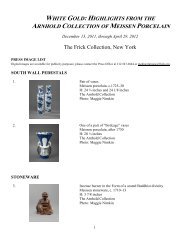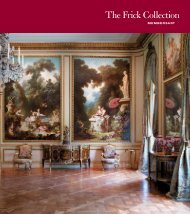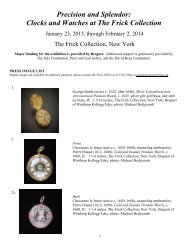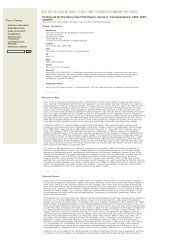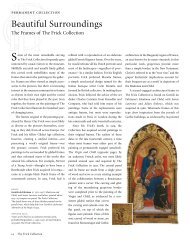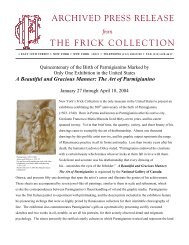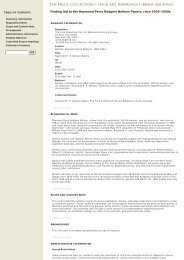ARCHIVED PRESS RELEASE THE FRICK COLLECTION
ARCHIVED PRESS RELEASE THE FRICK COLLECTION
ARCHIVED PRESS RELEASE THE FRICK COLLECTION
Create successful ePaper yourself
Turn your PDF publications into a flip-book with our unique Google optimized e-Paper software.
<strong>ARCHIVED</strong> <strong>PRESS</strong> <strong>RELEASE</strong><br />
from<br />
<strong>THE</strong> <strong>FRICK</strong> <strong>COLLECTION</strong><br />
1 EAST 70TH STREET • NEW YORK • NEW YORK 10021 • TELEPHONE (212) 288-0700 • FAX (212) 628-4417<br />
MAJOR EXHIBITION OF SCULPTURE THIS FALL<br />
AT <strong>THE</strong> <strong>FRICK</strong> <strong>COLLECTION</strong><br />
EUROPEAN BRONZES FROM <strong>THE</strong> QUENTIN <strong>COLLECTION</strong><br />
September 28, 2004, through January 2, 2005<br />
European Bronzes from the Quentin Collection is the first public exhibition of a distinguished, little-known private<br />
collection devoted to the art of the statuette from the sixteenth through eighteenth century, and New York’s Frick<br />
Collection is the sole venue. The exhibition features almost forty sculptures, including exemplary works by Italian<br />
masters of the genre such as Giambologna, Giovanni Francesco Susini and his<br />
uncle Antonio Susini, Francesco Fanelli, and Massimiliano Soldani-Benzi, as<br />
well as examples by their equally gifted northern contemporaries such as<br />
Hendrick de Keyser and Barthélemy Prieur. Primarily consisting of bronzes,<br />
with some works in terracotta and precious metal, the collection has been<br />
discriminatingly assembled over the last twenty-five years. Many, like<br />
Giambologna’s Mars and Sleeping Nymph, are outstanding examples of famous<br />
compositions. Other masterpieces, like the mysterious Allegorical Deity Seated on<br />
Grotesques, are new discoveries exhibited here for the first time. The<br />
compositional inventiveness, technical refinement, and sheer quality of these<br />
works endow the collection with its particular character, while an emphasis on the<br />
idealized human figure establishes its identity. Oil lamps, incense burners, and<br />
bells – those imaginative accoutrements of the Renaissance scholar’s study collected by Henry Clay Frick – are<br />
practically absent. Instead, the Quentin Collection presents some of the best examples by generations of European<br />
master sculptors who were inspired by the human form. The exhibition’s gathering of powerful, elegantly idealized<br />
nudes provides a focused introduction to the pleasures offered by the bronze statuette. The exhibition, coordinated<br />
Giambologna (1529–1608), Mars (detail), Modeled<br />
by Giambologna between late 1560s and early 1570s,<br />
Bronze (Cast before 1577, probably by Fra<br />
Domenico Portigiani), The Quentin Collection
y the Frick’s Associate Curator Denise Allen, is made possible through the generosity of The Quentin Foundation<br />
with additional support from the Fellows of The Frick Collection.<br />
Comments Chief Curator Colin B. Bailey, "The opportunity to exhibit such choice examples from the Quentin<br />
Collection is indeed gratifying: not only is each work of singular beauty and visual appeal, but the collection as a<br />
whole reflects the same commitment to quality that has inspired The Frick Collection since its inception. We are<br />
also delighted that the exhibition has served as a catalyst for the scholarly catalogue, which with its detailed entries<br />
and generous illustrations will surely make an important contribution to the field of Renaissance and Baroque<br />
bronzes."<br />
HIGHLIGHTS OF A REMARKABLE GA<strong>THE</strong>RING<br />
At The Frick Collection the Quentin sculptures will be displayed so that visitors<br />
may appreciate the union of naturalistic illusion with technical artistry that is the<br />
hallmark of the greatest figurative statuettes. Most of the sculptures, like<br />
Giambologna’s Mars, will be shown freestanding and without vitrines. This<br />
freedom of viewpoint allows the visitor to experience how the artist used the<br />
expressive logic of pose to identify the god of war with martial readiness. His<br />
muscles taut and eyes fixed on the enemy, Mars halts his stride, exploiting the<br />
force of arrested motion to swing his body and sword arm backward in<br />
preparation for attack. His free arm sweeps forward to balance his rotating<br />
Giambologna (1529–1608), Mars, Modeled by<br />
Giambologna between late 1560s and early 1570s,<br />
Bronze (Cast before 1577, probably by Fra<br />
movement, his hand poised at the instant it most resembles a gesture of<br />
Domenico Portigiani), The Quentin Collection<br />
command. By depicting Mars ready to strike, Giambologna celebrates the power<br />
and resolve leaders needed to wage war, or to prevent it. Late Renaissance rulers appreciated this ennobling lesson,<br />
and the Mars became a featured addition to their collections. No less coveted by princes and kings for its masterful<br />
artistry, Giambologna’s Mars displays the sculptor’s ability to depict the subtle movements of muscles bunching<br />
under skin, of eyes tightening in concentration, and of lips parting to draw in breath. This virtuoso combination of<br />
illusionism and technique is even more astonishing when one considers that the Mars is little more than fifteen<br />
inches tall.<br />
The focused compression of the Mars is typical of statuettes, for these small works were made first to delight and<br />
then to engage over numerous encounters. Statuettes compel the viewer to accept the human form as something<br />
that can be believably miniaturized to endlessly fascinating effect. By winning credence, statuettes inspire<br />
imagination. Such is the case of the Allegorical Deity Seated on Grotesques, sometimes attributed to the Dutch<br />
2
sculptor Adrian de Vries. The robust muscular ease with which the idealized nude deity sits astride bat-winged<br />
monsters so effectively subjugates the creatures that the group has been interpreted as an allegory of good<br />
triumphant over evil – all in a work that can be comfortably held within one’s hands. It is a witty inversion of size<br />
in proportion to theme that, like a fictive looking glass, draws its audience into a world where fantastic nightmare<br />
creatures, though small and subdued, have the power to haunt through their<br />
sharply realized believability. Composition, scale, and meticulously crafted<br />
detail provide insight into this sculpture’s meaning even though its exact<br />
subject and function have yet to be discovered.<br />
Each small bronze was made to evoke multiple associations that captivated the<br />
rulers and wealthy educated classes who collected them. The more we know<br />
about this history, the richer our understanding of this art form becomes.<br />
During the Renaissance collectors and sculptors often looked back to classical<br />
antiquity as a model. The anonymous northern Italian master of the Hercules<br />
and Antaeus, for example, based his composition on an over-life-size classical<br />
Probably Northern Italy, c. 1500–1525, Hercules &<br />
Antaeus,Bronze, Late Renaissance base of painted<br />
wood, The Quentin Collection<br />
marble fragment, then known even in its ruined state as “the most beautiful statue<br />
in Rome.” By imaginatively reconstructing the monumental, fragmentary marble<br />
in small-scale bronze, this sculptor rivaled the greatest achievements of the past<br />
and literally placed those achievements, miraculously restored, into the hands of<br />
his patrons. The sculptor of the Hercules and Antaeus also exploited his medium,<br />
allowing the metal’s inherent tensile strength to mimic Hercules’s strength as the<br />
hero hoists Antaeus into the air, the giant’s legs freely dangling without the strutted<br />
supports required by the original marble. The composition’s angular geometry and<br />
the figures’ blocky, flexed muscles echo the group’s marble origins and remind us<br />
that bronze is a molten medium that can take almost any form, its protean character<br />
limited chiefly by the artist’s ability to manipulate it.<br />
WORKS MEANT FOR <strong>THE</strong> COLLECTOR’S ENJOYMENT<br />
Renaissance statuettes were often displayed in the more private confines of the collector’s house or palace, where<br />
they were occasionally placed on tables so that they could be turned, touched and held. This intimate relationship<br />
between viewer and object frequently inspired sculptors. Giambologna, for example, crafted the smooth, silken,<br />
lacquered surfaces of the voluptuous Sleeping Nymph to invite the sense of touch. His sensual conception springs<br />
3<br />
Attributed to Adrian de Vries (c. 1556–1626), or to<br />
an Anonymous European Master, Allegorical Deity<br />
Seated on Grotesques (detail), c. 1600, Bronze,<br />
The Quentin Collection
from the sixteenth century’s interest in the sleeping female figure. In Venice the subject was popularized by the<br />
woodcut image of a sleeping nymph from the book The Dream of Poliphilus and was echoed in the paintings of<br />
Giorgione. In Rome a monumental classical marble statue of the sleeping Ariadne represented this paradigm, and<br />
Giambologna’s Nymph adopts the languid pose of that famous antiquity. In Florence, home of Giambologna and<br />
his Medici patrons, the subject was identified with Michelangelo’s<br />
celebrated monumental marble sculpture of Night. Florentine writers<br />
praised Michelangelo for so perfectly capturing Night’s sleep that her<br />
viewers remained silent, lest their voices wake her from stony slumber.<br />
Giambologna’s Nymph wittily plays, instead, on the relationship between<br />
sleep and the bronze statuette. Though sound might not rouse her, touch –<br />
the sense she most provocatively invites – could have the power to awaken<br />
this Nymph from her dreamlike repose.<br />
Giambologna (1529–1608), Modeled by Giambologna before<br />
1584, Sleeping Nymph (detail), Bronze, The Quentin Collection<br />
Seventeenth-century bronze statuettes, like Francesco Fanelli’s Mercury and<br />
Cupid, were often larger than their earlier Renaissance counterparts. At almost<br />
three feet tall, the Mercury and Cupid’s size and dramatic, sweeping forms were<br />
meant to harmonize with grand public spaces, like the picture galleries typical of<br />
this period. The sculpture’s subject is drawn from Apuleius’s tale of the starcrossed<br />
lovers Cupid and Psyche and illustrates Mercury about to proclaim that<br />
Psyche must be returned to the bondage of Cupid’s jealous mother, Venus.<br />
Fanelli depicts the winged god with his messenger’s trumpet in hand, poised at<br />
the instant of flight on cloudy winds that loft him skywards. The little Cupid<br />
clutching Mercury’s leg appears heavy by<br />
Francesco Fanelli (1577–after 1657), Mercury<br />
& Cupid, early 17 contrast, as he yields his weight like a ballast<br />
stone in a desperate attempt to halt the fateful<br />
flight. Cupid merely earns Mercury’s backward glance, and the lover’s cruel<br />
separation is sealed by the messenger god’s elegant, inexorable ascent. Fanelli’s<br />
complex story telling, which was rare in earlier statuettes, derives from the<br />
pictorial tradition and challenges it. Displayed at the center of a picture gallery,<br />
elevated and isolated on a pedestal, the Mercury and Cupid would have engaged<br />
viewers with a directness impossible for paintings to achieve. Fanelli crafts his<br />
narrative with the dramatic compression typical of sculpture. The composition’s<br />
graceful torsion invites viewers to walk round the work and unfold the tale.<br />
th century, Bronze,<br />
The Quentin Collection<br />
Francesco Fanelli (1577–after 1657), Mercury &<br />
Cupid (detail), early 17 th century, Bronze,<br />
The Quentin Collection<br />
4
The sculptor’s concise language of pose and gesture is movingly<br />
expressed by Massimiliano Soldani’s Pietà with Two Putti. Made<br />
during the early eighteenth century when Soldani was a master<br />
medallist to the Florentine Grand Dukes, the Pietà is one of the latest<br />
works in the Quentin Collection, and one of the few masterpieces in<br />
terracotta (fired clay). Soldani’s dead Christ with mourning angels is a<br />
compianto, a work intended for use during the Catholic devotions that<br />
aroused compassionate empathy for Massimilliano Soldani-Benzi (1656–1740), Pietà with Two Putti,<br />
probably 1715, Terracotta on original ebony base, The Quentin<br />
Collection<br />
the Savior’s passion and death.<br />
Christ’s body is gently elevated<br />
toward the viewer, exposing the bloody lance wound at his side. The crown of<br />
thorns and nails lie on the stony ground below. Beside them, closest to the<br />
viewer’s gaze, Christ’s hand opens upward in lifeless supplication. The sorrowful<br />
angels, who lovingly stare at the Savior’s face and kiss his wounds, serve as<br />
exempla for the emotions experienced by the devotee as he knelt before this image<br />
in private contemplation. The loosely flowing, masterful freedom with which<br />
Massimilliano Soldani-Benzi (1656–1740), Pietà with Two Putti,<br />
Soldani modeled the wet clay probably tempers 1717, Terracotta, the harrowing The group alone: 20.5 subject x 47 x 20.5 and cm endows the<br />
On original ebony base: 29.5 x 55 x 27.5 cm<br />
The Quentin Foundation Collection<br />
sculpture with a hushed, graceful lyricism that inspires meditation. In Soldani’s hands the Pietà is rendered<br />
compellingly beautiful. Soldani produced many larger more complex versions (which include the Virgin<br />
accompanied by numerous angels) in terracotta and in bronze, while porcelain examples were created after his<br />
death. The Quentin Pietà, however, is the only surviving version of this composition by Soldani in any medium.<br />
The rarity, refinement, and distilled emotional intensity of the Pietà stand as hallmarks of the memorably beautiful<br />
sculptures in the Quentin Collection.<br />
Massimilliano Soldani-Benzi (1656–1740), Pietà<br />
with Two Putti (detail), probably 1715, Terracotta on<br />
original ebony base, The Quentin Collection<br />
SCHOLARLY CATALOGUE INTRODUCES UNKNOWN WORKS<br />
The exhibition is accompanied by a scholarly catalogue, co-authored by Dr. Manfred Leithe-Jasper, Director<br />
Emeritus, Department of Sculpture and Decorative Arts at the Kunsthistorisches Museum in Vienna, and Patricia<br />
Wengraf, esteemed sculpture dealer. Leithe-Jasper and Wengraf introduce many heretofore unknown sculptures,<br />
backing their arguments and attributions with thorough research, the most up-to-date technical evidence, and the<br />
kind of expertise that can only be acquired by years of focused study in the field. In preparation for the publication,<br />
5
ten of the Quentin bronzes underwent full technical analysis at the National Gallery of Art, Washington, D.C.<br />
Shelley Sturman, Conservator and Head of Objects Conservation, has written detailed technical reports on this<br />
group. The catalogue, published by M.T. Train/Scala Books, is lavishly illustrated and includes a large number of<br />
comparative images, which are essential to the understanding of the intricacies of attribution inherent in this field.<br />
This publication (360 pages) is available in hardcover for $125.00 through the Museum Shop of The Frick<br />
Collection, the institution’s website (www.frick.org), or by calling (212) 288-0700.<br />
6
FREE PUBLIC LECTURE<br />
Date: Wednesday, September 29, 2004, 6:00pm<br />
Speaker: Manfred Leithe-Jasper, Director Emeritus, Department of Sculpture and Decorative<br />
Arts, Kunsthistorisches Museum Vienna<br />
Title: Learning by Doing: Cataloguing European Old Master Bronzes in the<br />
Quentin Collection<br />
The experiences gained from cataloguing bronze statuettes often provide new insights into the works of even wellknown<br />
sculptors such as Giambologna. Dr. Leithe-Jasper will focus on two of Giambologna’s most famous<br />
compositions, the Striding Mars and Sleeping Nymph, in his discussion of the process, progress, and surprises<br />
afforded by cataloguing the Quentin Collection sculptures. There is no charge for this lecture; seating is limited.<br />
Basic Information<br />
General Information Phone: (212) 288-0700<br />
Website: www.frick.org<br />
E-mail: info@frick.org<br />
Where: 1 East 70th Street, near Fifth Avenue.<br />
Hours: open six days a week: 10am to 6pm on Tuesdays through Saturdays; 1pm to 6pm on<br />
Sundays. Closed Mondays, New Year’s Day, Independence Day, Thanksgiving, and Christmas Day.<br />
Limited hours (1 to 6pm) on Lincoln’s Birthday, Election Day, and Veterans Day.<br />
Admission: $12; senior citizens $8; students $5<br />
PLEASE NOTE TO YOUR READERS: Children under ten are not admitted to the Collection, and those under<br />
sixteen must be accompanied by an adult.<br />
Subway: #6 local (on Lexington Avenue) to 68th Street station; Bus: M1, M2, M3, and M4 southbound on Fifth Avenue to<br />
72nd Street and northbound on Madison Avenue to 70th Street<br />
Tour Information: included in the price of admission is an Acoustiguide INFORM® Audio Tour of the permanent collection.<br />
The tour is offered in six languages: English, French, German, Italian, Japanese, and Spanish.<br />
Museum Shop: the shop is open the same days as the Museum, closing fifteen minutes before the institution.<br />
Group Visits: Please call (212) 288-0700 for details and to make reservations.<br />
Public Programs: A calendar of events is published regularly and is available upon request.<br />
#77, July 29, 2004<br />
For further press information, please contact Heidi Rosenau, Manager of Media Relations & Marketing<br />
Media Relations Phone: (212) 547-6866<br />
General Phone: (212) 288-0700<br />
Fax: (212) 628-4417<br />
E-mail address: mediarelations@frick.org<br />
7



